The road under the car is covered in thick ice, the trees are covered in snow and a herd of frosty bison can be seen off in a distant valley as steam rises up from one of many geysers. We’ve just arrived in Yellowstone mid winter, possibly one of the most beautiful places on earth.
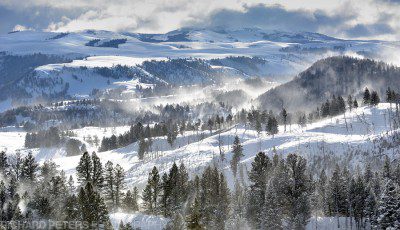
Welcome to the snow covered valleys of Yellowstone
This blog post is long overdue. My trip to Yellowstone was back at the start of the year, but I didn’t have time to write it all up when I returned home, and then posting a winter blog post in summer didn’t make sense. And so here it is now, late, but hopefully still a good read!
Also, I don’t use the word very often, but this blog post is pretty epic. It has to be as the place I’m writing about is. And so, I’ve split this in to three parts. Part one will cover the background behind the trip, as well as the travel experience and first two days in the park. Part two will cover days three to six, and the final part will cover the remaining days plus a few fun facts about the trip. Across those three I’ll drop in a few points about some of the challenges we faced along the way. I’ve also dotted some images in from my iPhone to illustrate a couple of the points I make just to serve as ‘behind the scenes’ images. So I hope you enjoy this approach and it helps you to appreciate the whole thing a little more. Yellowstone is an awe inspiring place, and I felt doing it this way would do the trip the justice it deserves as a real account of our time spent there rather than one shorter ‘summary’ style blog post.
WANT TO GO TO YELLOWSTONE? WHY YES, YES I DO!
Yellowstone is the world’s first national park and is spread across 3,472 square miles that span three of Americas states with 96% of the park being in Wyoming. It’s a place I’ve wanted to visit for many years, ever since seeing it for the first time many years ago on one of countless wildlife documentaries that feature it. So, when my friend and fellow photographer, Rene De Heer asked if I fancied going with him on a photo tour I barely even had time to think about saying yes before the words had come out of my mouth (or rather, been typed in to my replying email). Even once booked, it still hadn’t really sunk in that in 8 months time I’d be able to put a tick on one of my bucket list destinations. The trip was the Wolves of Yellowstone in Winter workshop/tour with American pro wildlife photographer and all round nice guy Robert Franz. The agenda was, with luck, to see the Wolves that inhabit the valleys in the winter months but of course, we’d take advantage of anything else we might come across whilst out there. The tour was officially a week long but we hired Dale out for an extra few days afterwards to make the most of time spent out there, otherwise it’s quite a way to travel just for one week!
TRAVELLING, WAITING AND JETLAG
Fast forward eight months and my camera bags were packed with my Nikon D3s and D7000 plus a variety of lenses (I did a separate video and blog post about the gear I took) and I was at Heathrow terminal five meeting Rene, about to undergo the very long journey. Our excitement levels were quite high, as Dale has been updating us all via email as to what was going on in the park during the final weeks leading up to the departure. The journey to our final destination, the town of Gardiner, would take us from Heathrow Airport across the Atlantic to Denver on a 10 hour flight. At Denver we would met up with Rene’s friend, another Dutch veteran wildife photographer Hans Schouten before waiting 4 hours for our connecting flight to Bozeman. This flight was only an hour and a half to Bozemans tiny airfield but once there and despite the small size we still had a 45 minute wait for our bags to arrive, followed by another half an hour wait for our hotel shuttle bus. When we finally arrived at The Comfort Inn at Bozeman it was gone 10pm U.S. time, and we had been travelling for just over 20 hours. To say we were tired would be an understatement. Jet lag doesn’t normally have a huge impact on me when flying across the Atlantic, but this time round with the connecting flight and extra travel it really took a firm hold and with only two hours sleep the night of arrival, I spent the following day pretty much collapsed in my hotel room resting. It was, however, a great surprise to pull the curtains back the next morning after those two hours sleep and see mountains all around us off in the distance. We had arrived by cover of darkness so had no idea what the landscape looked like. It certainly helped lift my spirits.
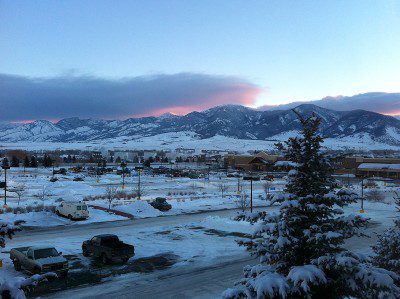
Pulling back the curtains after 20 hours travel revealed this (iPhone)
The only time I ventured out of my room was a quick walk to Walmart and then to meet a very nice guy called Matt, who I got chatting to via Twitter. He lives in Bozeman and had kindly offered to let me order some snow boots from a U.S. supplier whilst I was back in the UK, and have them delivered to his house. So thank you Matt, not only for allowing me to send them to you, but also for dropping them to me at the hotel! 🙂
THE ADVENTURE BEGINS
With a bit more sleep under our belts, Saturday saw us going back to Bozeman’s airfield where we would be picked up by Dale and meet the rest of the six strong group of photographers we’d be with for the coming week, Steven Berkowitz, Jamie Strickland and Art Hyder.
Dale picked us up at lunch time and we took a beautiful scenic drive down US 89 towards Gardiner, which is right on the East entrance to Yellowstone and would be our base for the coming days. The drive is stunning, and in some ways reminded me of driving through the Scottish Highlands. The Yellowstone river runs alongside much of the road and the closer to Yellowstone we got, the bigger the surrounding mountains became, and the more snow covered the scenery. We spotted four bald eagles on the drive in as well as several other raptors, which was a fantastic bonus, not least because it gave us a glimpse of what we might see in the coming days.
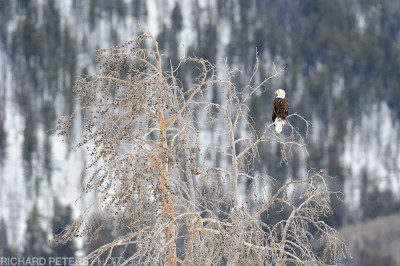
A bald eagle sits high atop a bare tree
Upon arrival we were greeted by a heard of Bison walking down the main street. A great way to officially be welcomed to the small town of Gardiner. Bison and deer freely roam the small town and we saw another herd of 20 or so in the towns school playing field. We arrived at our hotel and did a quick unpack, before heading out for an hour or so along the road that runs along the outside of the park. We got up close and personal to another small group of bison and saw a few pronghorn antelope dotted around but we didn’t spend too long out as the light was fading and clouds drawing in. So, we headed back to the hotel to put the gear away then went to a local cafe for our welcome dinner, before retiring back to the hotel for an early night as the tour was officially starting the next morning. A morning which, according to my iPhone, was going to be around -10f (-23c).
DAY ONE: THE HAZARDS AND OUR FIRST WILDLIFE ENCOUNTERS
Our days would start the same, up between 5:30 and 6am for breakfast in the hotel before loading up the cars with the 18 or so cameras we had between us and heading out in to the park before sunrise, where we would drive the only open road through the park in a convoy of two cars with three of us plus driver in each. The road is almost 60 miles long and takes you from Gardiner to Mammoth Hot Springs, just a fifteen or so minute drive, then on to Cooke City over 50 miles away. Because the wildlife could be anywhere and with several reports of coyotes amongst other species being seen close to Mammoth Hot Springs we didn’t need to be in the heart of the park for first light as driving through in the dark you could easily miss things at any point. It was also overcast so no nice early morning light for our first venture out. Every morning, our drive through the park would be to the sound of the weather report coming across the radio, and every morning it was the same. Cold. And it was never wrong. Yellowstone in winter is just that, and then some.
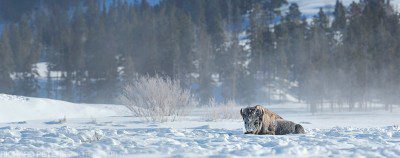
5 shot Bison panoramic, Nikon D3s with 600mm
As we followed the road higher and higher in to the mountains, the scenery became more and more breathtaking. Everywhere you look there are either snow covered trees, valleys far below or pockets of steam hinting at the geysers that litter the national park. If you’ve never experienced something like this before, it’s almost hard to explain in words just how beautiful the landscape is. But, it’s also hazardous, and Dale warned us that great care needs to be taken as the road through Yellowstone is, for the most part, covered entirely with snow and ice making it a slow drive and a 4×4 essential. He went on to explain to us that if we saw anything we wanted to photograph, we would have to get out and he would drive up the road then come back for us if there was no pull over area. There are very few parking spots along the roads here and just abandoning your car wherever you see fit is a dangerous hazard in these conditions. But even if you jump out you need to be careful because the park rangers don’t like photographers standing in the road, so if they see you, they ask you to move off to the side. Not easy if there is a 4 foot snowbank, and even more dangerous if there isn’t because the snow under foot can be anywhere from five inches to 5 feet deep! You also need to keep in mind that because you are up at around 8,000 feet above sea level, the air is a lot thinner and you get tired far more quickly if you are lugging 10kg of camera gear around. Make no mistake, it may be stunning to look at but you need to take great care here in the winter with almost everything you do.
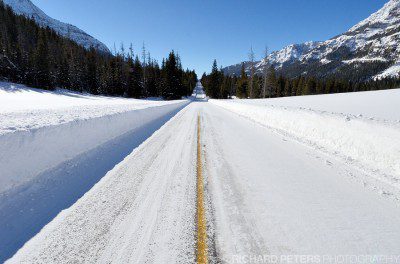
Ice covered road with four foot snowbanks.
We rounded the corner to Lamar Valley for the first time and it really was quite an experience to see this vast expanse open up before us and stretch out in to the horizon. We parked up to take in the view and scour the surroundings for signs of life, of which there were none. But this stop off served as a reminder to wear sunglasses as with the glare of the sun and no shade in sight, this vast expanse of a frozen white landscape was almost blinding and I literally had trouble keeping my eyes open at times. Thankfully, I had planned for this, and grabbed my sunglasses from deep within my camera bag.
We made our way further along the valley road and noticed a huge group of people parked up. Apart from the odd car we’d passed here and there this was our first sighting of a real gathering and with so many telephoto lenses on show we knew there must be something of interest. We hoped for a wolf, but there, out in the middle of the valley was our first glimpse of a Red Fox. We watched it walk across the snow, stopping from time to time to listen for mice activity underneath the snow cover. We watched for a good twenty minutes hoping for it to start mousing and leaping in to the air so as to come down and dig deep in the snow, however, it slowly wondered further and further away so we headed on to Cooke City for lunch before making the return journey back towards Gardiner in the afternoon.
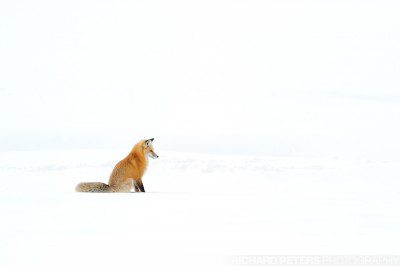
A red fox sits and listens for mice under the snow. D7000, 600mm + 1.7x TC
On the return journey we came across a small heard of bison grazing just as a blizzard rolled in. So, we jumped out and got some nice images of the bison in the heavy snow. We spent a good fifteen minutes with the bison in the blizzard, but with every passing minute the snow got thicker and the bison further away.
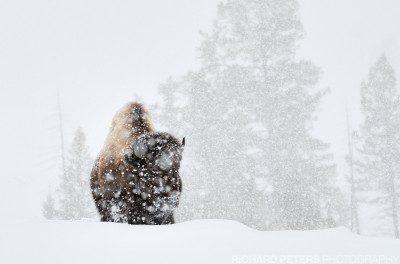
Bison in a blizzard, Nikon D7000, 70-200 VR
I’d not experienced snow quite this thick before, with visibility severely reduced and auto-focus completely unusable so it was quite the challenge to try and manual focus on our subjects. Fantastic weather to photograph in though and a real test for the D7000 I was shooting with as the snow was settling on both it, and my 70-200 and neither had any type of cover on.
Heat haze and atmospherics
Reviewing the first days images back at the hotel that evening revealed an issue that would crop up quite a bit during the trip. For those of you that don’t know, the further away from you the subject is, the more air there is between you and them, and if that air is anything other than crisp, clean and clear, it will impact on your images. Well, with all that bright white snow reflecting the sun and with steam rising from under ground it caused havoc with our optics with heat haze rendering almost all of my red fox images unusable bar one or two. But, who said photographing in a wildlife photographers paradise would be easy… 🙂
No wolf sightings yet.
DAY TWO: THE SNOW COACH
This was to be the first of two snow coach days. During winter the majority of the park is closed to regular cars and the only way to see the interior is either by snow coach or snowmobile. It was a bitterly cold morning with the temperature sitting around the -20f (-28c) mark. So cold in fact, that the inside windows of the snow coach needed to be wiped clear constantly otherwise the condensation would freeze to the inside of them. The coach held the 8 of us plus the driver, and I’ve got to be honest it was hard work just getting us all in. It’s basically a van with snow tracks instead of standard wheels, and we all had to gain access via one sliding door on the side.
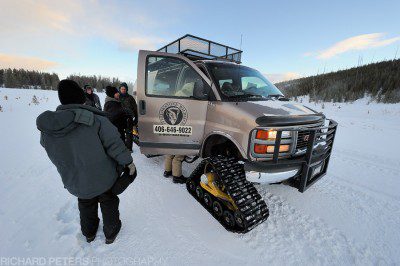
The snow coach. Noisy and uncomfortable if the roads are not smooth.
There were 3 benches inside so with the exception of the driver and passenger seat up front, the rest of us had to squeeze in the back along with our cameras and bags and wearing all our very thick cold weather clothing! Not easy, and very cramped which made getting out when we stopped to take photos very tricky and slow! Our tripods had their own little box on the outside of the coach, although calling it a freezer would be more accurate as every time we stopped to take photos, the box was covered in fresh ice that needed to be broken off to gain access to the tripods again. It was also a very noisy and bumpy ride as the roads are only open to snow coach and snow skis, and they put large holes in the snow on the road, so the coach bumps and sways all over the place at times (very similar to being in a boat on a rough sea).
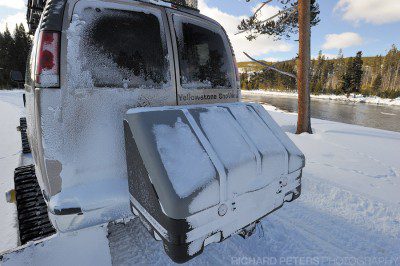
The tripod box, aka the freezer
Unlike day one, we saw very little wildlife activity on our trip to Old Faithful in the morning with the exception of a small herd of bison at first light. In the afternoon there were some bison encounters and we spotted two bald eagles in a tree and a red fox way across the Madison River but that was it. I think it would be fair to say it wasn’t the most enjoyable of experiences and we all felt quite drained from the journey. Good wildlife sightings would have made the uncomfortable ride bareable, but as you know, you can never count on anything when it comes to wildlife photography. I think it would be fair to say we were all glad to get off the coach at the end of the day as it simply wasn’t big enough to carry that many photographers plus equipment comfortably. We headed back to the hotel, with barely a memory cards worth of images between us. Thankfully, and unbeknown to us at the time, the next day would prove to be far more productive…
No wolf sightings yet.
PART TWO
Want more? Read Part two of my Yellowstone Winter Wildlife trip.








